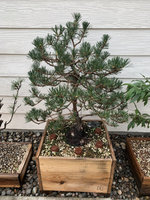Brian Van Fleet
Pretty Fly for a Bonsai Guy
Pretty sure you won’t want to summer candle-cut a Kotobuki, but in the fall, it needs to be pruned back pretty hard to get some back-budding. Repeated pruning over a few years will increase the density and allow you to compact the design around that big fat base.Correct.






